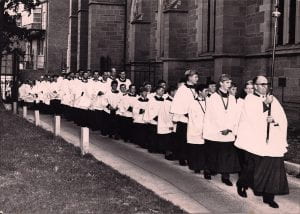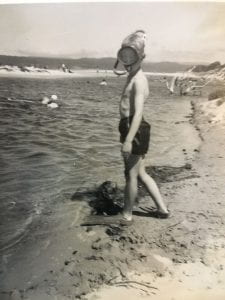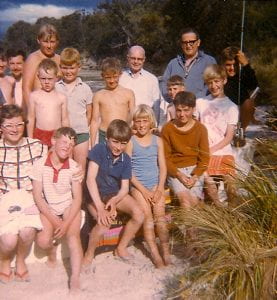My discovery of commonality with a Rolling Stone originated in my search for the highest note achieved in the famous hymn ‘I Was Glad’ by Hubert Parry, often performed at British coronations (it was performed as Catherine Middleton walked down the aisle of Westminster Abbey to wed William). After the usual scramble around multiple websites, I ended up in the Wikipedia entry on ‘boy soprano’, where it was noted that “Keith Richards sang as a choirboy in a trio of boy sopranos for Queen Elizabeth II at Westminster Abbey in the 1950s.” Yes, I too was an Anglican choirboy, but never in such an esteemed setting.
I don’t know what motivated my mother to take me along to St David’s Cathedral Choir in Hobart in the late 1950s. Perhaps the church advertised for new choirboys in The Mercury. Whatever, for some equally unknown reason I succumbed to her wishes and commenced my chorister career. Alongside the baritones, tenors and altos, the sopranos (also known as trebles) were divided into Decani and Cantoris, with Decani (of which I was a member) taking the higher parts when we sang harmonies. The boys practised on a Tuesday after school, and the full choir met every Thursday evening. This required me to catch a bus each way, not unusual at the time for a small boy under 10. The culmination of all the practice was the Sunday morning service: we would assemble in the crypt, don our purple cassocks and white surplices, and process grandly into the choir stalls accompanied by the beautiful church organ, magnificently played by John Nicholls, city organist and choirmaster.

The choir in procession – by this time I was head boy of Decani. The event was probably the inauguration of Bishop Davies in 1963.
I have many fond memories of my years as a choirboy. I was taught how to sing, I made good friends, I was introduced to Bach, and I learned to love (most of) the music we sang. It was joyous and fun. There were regular special events, the most obvious being Easter and Christmas, others including a full recital of Bach’s St Matthew Passion (though I recall being impatient with the adult solos – we just wanted to get on with the rowsing choruses).
You may be surprised to learn that we were paid for our efforts: depending on your seniority, you’d receive a scholarship payment varying from 10 shillings up to six pounds for each of the two head boys. And if you turned up for a wedding, you’d get equal share of the 30 shillings the groom was required to hand over for the joy of having a small band of choirboys join the ceremony.
An annual highlight was Choir Camp, held during the summer holidays at Coningham, near Snug. Yes there was plenty of practising of hymns, anthems, etc., but there was also free time. This we used for our own pleasure, the greatest of which was spearfishing. This sounds grander than it was, as the main implement was a broom handle with a metal barb or two attached with string. We had goggles, flippers and snorkel, but no wetsuit of course. I can’t remember noticing the cold water (which it must have been) and most of our catch was thrown back (especially the spiny puffer fish), but we speared flathead and flounder, and did once catch a large conger eel which was cooked by one of the mothers dragooned to assist.
We also smoked a lot at camp. Cigarettes were easy to get, as the local shopkeeper in Snug was more than happy to sell us our prized Benson and Hedges, as well as menthols, the name of which escapes me (Alpine?).
Getting back to top notes, I recall that we trebles in Decani felt a tad superior to our Cantoris colleagues, as we sang the upper part in any harmony, due to our ability to hit the high notes.
And just what is considered the upper range of a boy soprano? As the Wikipedia entry explains,
Most trebles have a comfortable range from the A below “middle C” (A3, 220 Hz) to the F one and a half octaves above “middle C” (F5, 700 Hz)[10], roughly corresponding to an adult male baritone range, up one octave. Some writing demands higher notes; the Anglican church repertory, which many trained trebles to sing, frequently demands G5 (784 Hz) and A5 (880 Hz).[11] Some trebles, however, can extend their voices higher in the modal register to “high C” (C6, 1109 Hz). The high C is considered the defining note of the soprano voice type.
I’m not totally sure of my ability to reach ‘high C’, but suspect I could. After all, I well remember triumphantly singing the third last note of ‘I Was Glad’, a high B (meanwhile, my Cantoris colleagues were belting out the F below high B – you know, the top line of the treble staff). It’s well worth a listen, and here’s a version from St Paul’s Cathedral Choir:
But all good things come to an end, and mine came somewhat ignominiously. It was during the weeks leading up to Christmas that small groups of choirboys would visit the Royal Hobart Hospital to sing Carols around the wards. I’d always enjoyed it, until the day when, while attempting to sing solo the line ‘Sire, he lives a good league hence, …’ could only let out a strangled croak. After failing a second attempt, the choirmaster asked my underling to take over, much to my embarrassment and shame. I left the choir early in the new year.

